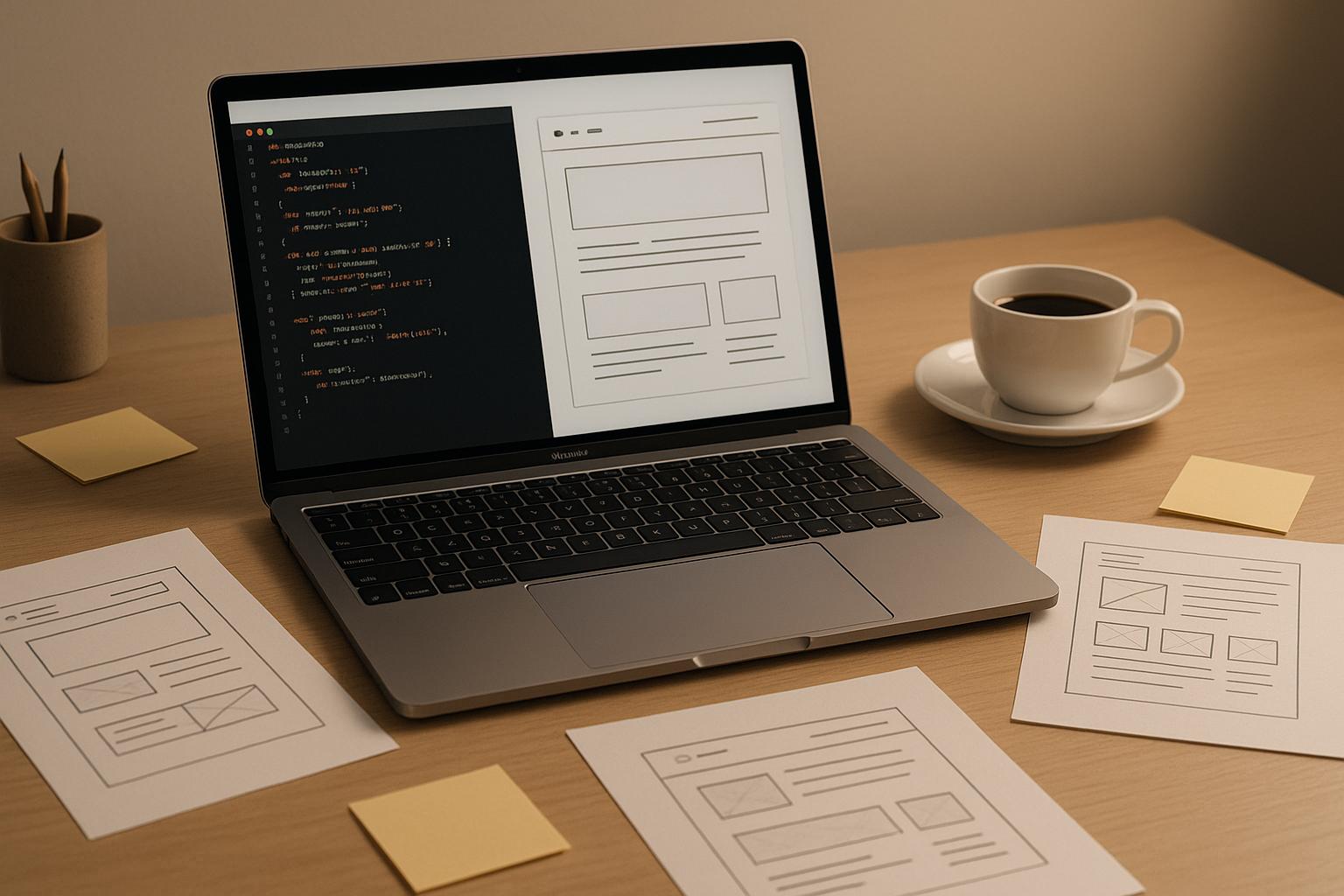let’s work together



Custom web development costs vary widely depending on several factors. Here's the gist:
Small business websites often cost less due to simpler needs, while e-commerce and enterprise platforms require larger budgets. To manage costs, define clear priorities, focus on essential features, and consider phased development.
Investing in custom web development can be costly upfront but pays off by aligning with your business goals and ensuring long-term scalability.
The cost of custom web development depends on a mix of factors like project scope, design needs, technology choices, team expertise, and location. To help you align your budget and make informed decisions, let's explore these elements in more detail, starting with project complexity.
The complexity of your project is a major driver of cost. For instance, a simple brochure website takes far less time to develop than an enterprise platform with custom dashboards, API integrations, and advanced security measures.
Database architecture also adds to the complexity. If your project involves custom designs, data migration, or real-time data processing, it will require more time and specialized expertise.
Design is another significant cost factor, especially when your project calls for unique visual elements or interactive features. Template-based designs are generally more affordable, while fully customized interfaces demand a higher investment.
If you want to enhance user engagement and conversions, investing in UX research and custom visuals can make a big difference. Features like animations, interactive elements, and responsive designs for various devices require specialized skills and additional development time to ensure a polished, user-friendly result.
The level of brand customization also impacts pricing. Projects that involve unique iconography, illustrations, or intricate visual effects require more design resources. Additionally, ensuring accessibility compliance and cross-browser compatibility adds to both the design and development workload.
The tools and technologies used for your project have a direct impact on costs. Modern frameworks like React, Next.js, and Node.js offer powerful capabilities but require developers with specialized knowledge.
Content management systems (CMS) are another consideration. While adapting an existing CMS is often more budget-friendly, custom CMS development offers greater flexibility but usually involves higher costs.
Integrating third-party services - like payment gateways, CRM systems, or marketing tools - can also add complexity. If you're incorporating advanced technologies such as AI-powered features or machine learning, expect these to influence your budget as well. Features like chatbots, personalization engines, or predictive analytics require specialized expertise and may come with ongoing service fees.
The skill level and structure of your development team play a huge role in both the efficiency and cost of your project. Highly experienced developers tend to charge more due to their advanced skills, while less experienced professionals may offer more affordable rates.
Full-service agencies often provide a one-stop solution, handling project management, design, and development all in one place. While this can streamline communication and ensure consistent quality, it typically comes with higher overhead costs compared to working with individual freelancers.
Specialized teams that include front-end and back-end developers, UI/UX designers, and project managers are well-equipped to deliver high-quality results efficiently.
Where your development team is based can significantly affect pricing. Developers in major tech hubs or urban areas in the United States often charge higher rates compared to those in smaller markets or more remote locations.
For example, senior developers in high-cost regions tend to command premium rates, while those in cost-competitive areas may offer more affordable options. Remote teams, in particular, are becoming increasingly popular, providing access to a diverse talent pool at potentially lower costs.
When working with remote teams, it's important to consider factors like time zone differences, communication methods, and project management capabilities to ensure smooth collaboration and quality outcomes.
Custom web development costs can differ significantly depending on the complexity of the project, the design requirements, and the expertise of the team involved. Below is an overview of cost ranges for common types of projects.
Websites for small businesses usually lean toward simpler designs with fewer features. Costs depend on factors like the level of customization, the number of pages, and any additional functionalities required. These websites often include basic elements such as contact forms, details about services, and an "About Us" section - perfect for establishing an online presence. It's also important to factor in costs for ongoing maintenance, security updates, and marketing efforts.
Budgeting for custom web development requires clear priorities and adaptable planning to avoid unexpected expenses. Here are some practical strategies to help you manage your budget effectively.
Start by listing everything your website absolutely needs, followed by features that would be nice to have. This helps you stay focused and prevents unnecessary expenses. Begin with your primary business goals - whether it’s generating leads, selling products, or showcasing your work.
Break your features down into three categories: must-have, should-have, and could-have. Allocate around 60-70% of your budget to must-have features, 20-30% to should-have features, and 10-20% to could-have features.
For example, if you’re building an e-commerce site, core features like product catalogs, shopping cart functionality, and payment processing should take priority over extras like customer reviews or advanced filtering options.
To avoid confusion later, document your specific functionality requirements before hiring developers. This ensures everyone is on the same page and makes it easier to compare quotes from different teams.
Once you’ve nailed down your priorities, find a development team that aligns with your vision. While experienced professionals may charge more upfront, they often save you money in the long run by working efficiently and avoiding costly mistakes.
A good development team won’t just focus on technical specs - they’ll take the time to understand your business goals. They should be able to explain technical concepts clearly and provide realistic timelines. Look for teams that offer cost-effective solutions and flag potential challenges early.
When evaluating teams, check their case studies, client reviews, and communication practices. Strong communication is key - teams that provide regular updates and ask thoughtful questions are less likely to blow through your budget or miss deadlines.
Remember, the cheapest option isn’t always the best. A team charging $150 per hour and completing your project in 200 hours will cost less overall than a team charging $75 per hour but taking 350 hours to finish the same work.
Your initial development budget is just the start. Be prepared for ongoing expenses like hosting, security updates, and content management. For example:
These ongoing costs typically account for 15–25% of your original budget. It’s also smart to set aside 15–20% as a contingency fund for unexpected needs.
If your budget is tight, consider phased development. Launch a minimum viable product (MVP) with essential features first, then add more functionality over time. This approach lets you start generating revenue or gathering user feedback sooner.
For instance, you could launch an e-commerce site with basic product listings and manual order processing, then add automated inventory management and advanced search options in a later phase. Phased development is especially helpful for startups and small businesses working with limited resources.

When it comes to custom web development, choosing the right partner is crucial. You need a team that blends technical know-how with strategic thinking. Realmonkey offers a full range of services - including branding, UI/UX design, web and app development, and marketing strategies - that help create a strong online presence. Here's a closer look at how Realmonkey stands out in the custom web development space.
Realmonkey uses cutting-edge technologies combined with tailored UI/UX designs to ensure your digital platform aligns with your business goals. Every project is designed to provide a polished, user-friendly experience that resonates with your audience.
Effective project management is at the heart of Realmonkey's approach. They prioritize clear communication and adaptable planning to ensure your platform stays relevant in an ever-changing market. This approach not only reduces risks but also enhances the return on your investment.
Realmonkey understands that every business has unique needs and budgets. That’s why they offer a variety of service plans, each designed to cater to different requirements:
These plans are flexible and scalable, designed to grow with your business. Whether you're a startup or an established enterprise, Realmonkey works with your goals, timeline, and budget to deliver tailored solutions.
The cost of custom web development hinges on several factors: the complexity of the project, design requirements, chosen technologies, the expertise of the development team, and even the geographic location of your developers. Each of these elements plays a role in shaping the final price tag.
For small businesses, creating a basic website typically requires a more modest budget. On the other hand, e-commerce platforms and enterprise-level solutions often demand larger investments due to the need for advanced features, integrations, and scalability.
To budget effectively, it’s essential to break down these factors. Start with clear requirements, prioritize the most important features, and consider phased development. This approach helps manage costs while ensuring you can launch key functionality on time. Don’t forget about ongoing expenses like hosting, maintenance, and updates - these recurring costs can add up over time and should be part of your financial planning.
When it comes to choosing a development partner, look for a team that blends technical know-how with strategic thinking. For example, Realmonkey offers AI-powered tools, custom UI/UX design, and flexible service plans to fit a variety of budgets. Whether you’re a small business or a large enterprise, finding a partner that aligns with your goals and budget is key.
Investing in custom web development is about preparing for the future. While the upfront costs can feel steep, a well-built solution pays off through better performance, scalability, and alignment with your business objectives. The right team will not only understand your vision but also deliver results that make the investment worthwhile.